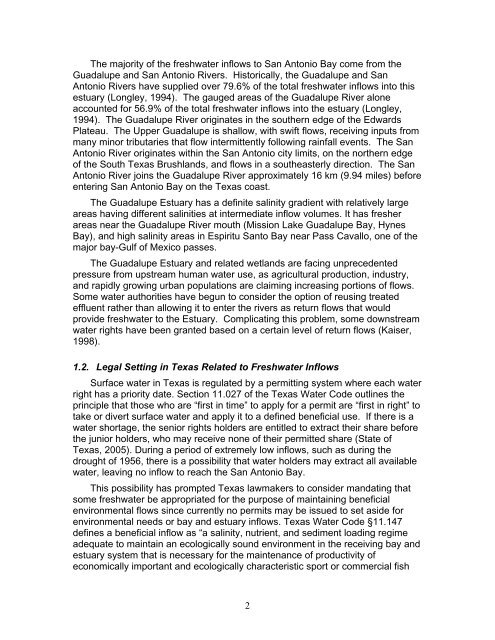The Economic Value of Water and Ecosystem Preservation
The Economic Value of Water and Ecosystem Preservation
The Economic Value of Water and Ecosystem Preservation
Create successful ePaper yourself
Turn your PDF publications into a flip-book with our unique Google optimized e-Paper software.
<strong>The</strong> majority <strong>of</strong> the freshwater inflows to San Antonio Bay come from the<br />
Guadalupe <strong>and</strong> San Antonio Rivers. Historically, the Guadalupe <strong>and</strong> San<br />
Antonio Rivers have supplied over 79.6% <strong>of</strong> the total freshwater inflows into this<br />
estuary (Longley, 1994). <strong>The</strong> gauged areas <strong>of</strong> the Guadalupe River alone<br />
accounted for 56.9% <strong>of</strong> the total freshwater inflows into the estuary (Longley,<br />
1994). <strong>The</strong> Guadalupe River originates in the southern edge <strong>of</strong> the Edwards<br />
Plateau. <strong>The</strong> Upper Guadalupe is shallow, with swift flows, receiving inputs from<br />
many minor tributaries that flow intermittently following rainfall events. <strong>The</strong> San<br />
Antonio River originates within the San Antonio city limits, on the northern edge<br />
<strong>of</strong> the South Texas Brushl<strong>and</strong>s, <strong>and</strong> flows in a southeasterly direction. <strong>The</strong> San<br />
Antonio River joins the Guadalupe River approximately 16 km (9.94 miles) before<br />
entering San Antonio Bay on the Texas coast.<br />
<strong>The</strong> Guadalupe Estuary has a definite salinity gradient with relatively large<br />
areas having different salinities at intermediate inflow volumes. It has fresher<br />
areas near the Guadalupe River mouth (Mission Lake Guadalupe Bay, Hynes<br />
Bay), <strong>and</strong> high salinity areas in Espiritu Santo Bay near Pass Cavallo, one <strong>of</strong> the<br />
major bay-Gulf <strong>of</strong> Mexico passes.<br />
<strong>The</strong> Guadalupe Estuary <strong>and</strong> related wetl<strong>and</strong>s are facing unprecedented<br />
pressure from upstream human water use, as agricultural production, industry,<br />
<strong>and</strong> rapidly growing urban populations are claiming increasing portions <strong>of</strong> flows.<br />
Some water authorities have begun to consider the option <strong>of</strong> reusing treated<br />
effluent rather than allowing it to enter the rivers as return flows that would<br />
provide freshwater to the Estuary. Complicating this problem, some downstream<br />
water rights have been granted based on a certain level <strong>of</strong> return flows (Kaiser,<br />
1998).<br />
1.2. Legal Setting in Texas Related to Freshwater Inflows<br />
Surface water in Texas is regulated by a permitting system where each water<br />
right has a priority date. Section 11.027 <strong>of</strong> the Texas <strong>Water</strong> Code outlines the<br />
principle that those who are “first in time” to apply for a permit are “first in right” to<br />
take or divert surface water <strong>and</strong> apply it to a defined beneficial use. If there is a<br />
water shortage, the senior rights holders are entitled to extract their share before<br />
the junior holders, who may receive none <strong>of</strong> their permitted share (State <strong>of</strong><br />
Texas, 2005). During a period <strong>of</strong> extremely low inflows, such as during the<br />
drought <strong>of</strong> 1956, there is a possibility that water holders may extract all available<br />
water, leaving no inflow to reach the San Antonio Bay.<br />
This possibility has prompted Texas lawmakers to consider m<strong>and</strong>ating that<br />
some freshwater be appropriated for the purpose <strong>of</strong> maintaining beneficial<br />
environmental flows since currently no permits may be issued to set aside for<br />
environmental needs or bay <strong>and</strong> estuary inflows. Texas <strong>Water</strong> Code §11.147<br />
defines a beneficial inflow as “a salinity, nutrient, <strong>and</strong> sediment loading regime<br />
adequate to maintain an ecologically sound environment in the receiving bay <strong>and</strong><br />
estuary system that is necessary for the maintenance <strong>of</strong> productivity <strong>of</strong><br />
economically important <strong>and</strong> ecologically characteristic sport or commercial fish<br />
2
















